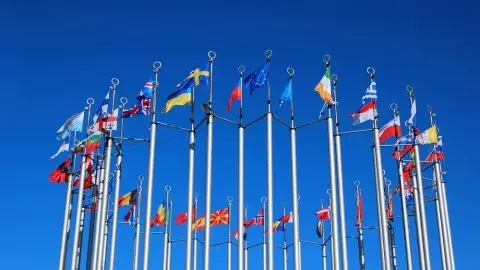ECB add fallen angels: More could follow
The ECB is to expand its collateral eligibility to fallen angels and we believe potentially all BB debt down the line. As long as a fallen angel was investment grade on 7 April, and remains at BB rating or above, they will be collateral eligible. We think this should benefit spreads and importantly financing possibilities for € high yield
The European central bank held a call last night to discuss whether or not to include junk bonds in its collateral framework. It was a very general discussion, which has ‘Italy’ written all over it. Markets expect S&P to come up with an updated rating for Italy later this week, and there is a risk that Italian debt could start its slide to junk status. This discussion comes a week ahead of the next ECB meeting on 30 April and has increased speculation about additional measures the central bank could take to limit an ‘unwarranted’ widening of spreads.
The precedent set last week by the Federal Reserve when it included 'fallen angels' bonds (an investment-grade issuer downgraded to high yield) in its purchase programmes and the inclusion of Greece as eligible collateral has created a clear direction for the ECB. Hence, we believe the ECB would add fallen angels to its corporate debt programmes (CSPP and PEPP asset purchase programmes). The Fed went a step further to add high yield ETFs to the purchase list. The ECB is not likely to take that route and also buy ETFs because of its more extensive QE (relative size and longer maturity). However, next Thursday we could well see collateral eligibility expansion to include all BB debt including eligible corporate and thus really support (lower-rated) BBB debt and € high yield market. Please see our report published last week here.
We believe the ECB would add fallen angels to its corporate debt programmes but won't go as far as the Fed and buy ETFs
Prior to this the collateral accepted in the credit space needed to be investment grade (one rating agency suffices) and includes financial debt (although this is not CSPP eligible - in the past we have frequently discussed the ECB perhaps including preferred debt).
Adding fallen angels is of paramount importance, as the financing conundrum for investment-grade corporates offers far more opportunities compared to high yield. Often commercial paper programmes, bond purchasing programmes, primary bond markets themselves and an array of government support all favours lower leveraged investment-grade corporates, leaving financing for high yield issuers as a real challenge. Even under our relatively positive Covid-19 base case, we estimate up to 10% of BBB debt will fall to high yield over the next 12-18 months. That is almost €70bn. One source of relief would be this move by the ECB and that thankfully that most investors (including the ECB) can hold onto fallen angels after a downgrade so as not to become forced sellers.
We continue to prefer eligible debt but given current market retracement, demand for credit in the long-end of the curve and this programme, we would not be too worried about adding to BBB and potential fallen angel debt exposure. We also think the BBB to BB spread difference can fall to 150bp consequently. Besides, the move is also beneficial to Italian corporate eligible debt, which hence we would expect to see tighten irrespective of whether it’s only a fallen angel collateral expansion or broader BB debt inclusion.
Fig 1: BBB & BB universe breakdown

Fig 2: BBB & BB universe per sector

There has already been a significant rise in downgrades over the past two years, as illustrated in Figure 3. Therefore, we are likely to see a higher negative rating migration, and continued downgrade dominance. The significant liquidity financing by corporates at the moment, paired with reduced earnings, will be detrimental to leverage ratios, which will, in turn, lead to a higher level of downgrades. We believe many corporates will happily take the risk of a downgrade in return for shoring up liquidity to ensure longterm survival. We believe this financing in BBB debt will gain further traction now the ECB will start purchasing falling angels.
There has already been a significant rise in downgrades over the past two years, and we are likely to see a higher negative rating migration, and continued downgrade dominance
As mentioned, we believe up to 10% of the BBB universe could fall into high yield. This means, as identified in Figure 1, that up to €66bn worth of BBB debt could be downgraded as a fallen angel. Although it is potentially more likely to have BBB- debt fall to junk, it is still very much possible for BBB+ issuers to fall. As it stands, close to 50% of the BBB universe is at the higher end of the rating (BBB+). Similarly, in the BB universe, BB+ accounts for over 60%. Of course, this is based on ING’s base case scenario of a gradual recovery, whereby we hit a 10% default level. If we were to see a prolonged lockdown, we expect fallen angels to reach up to 20% of the BBB universe, as there will be considerably more downgrades and defaults across the board.
Consumers, which includes all autos, hold the most substantial amount of BBB debt. Indeed, this sector has been hit somewhat severely in this crisis, and as a result, we may see significant fallen angels here.
Fig 3: European Rating Migrations

Now the occurrence of high yield support from the ECB, we expect performance of BB spreads. As seen in Figure 4, the differential between BBB spreads and BB spreads has risen considerably in 2020. The differential has only recently started to retrace a little, currently at about 200bp, and looking at earlier peaks, a target around the 120-140bp mark seems achievable. In terms of the BBB curve more steepness would be expected and as such we would look for the short end here to really perform.
What is interesting about this is that the recent peak in the differential levels was close to those of the sovereign debt crisis in 2011 and the oil crisis in 2016 but did not come close to the levels seen in the global financial crisis in 2008
On a more cautious note, what is interesting about this is that the recent peak in the differential levels was close to those of the sovereign debt crisis in 2011 and the oil crisis in 2016 but did not come close to the levels seen in the global financial crisis in 2008, where we also saw far more substantially inverted curves in BBB. Hence there is a significant downside here, under a considerably worsening Covid-19 scenario, matched with lack of further support for high yield, so we might expect the differential to climb once more reaching the levels hit in 2008.
Fig 4: BBB BB Differential and BBB Curve

This publication has been prepared by ING solely for information purposes irrespective of a particular user's means, financial situation or investment objectives. The information does not constitute investment recommendation, and nor is it investment, legal or tax advice or an offer or solicitation to purchase or sell any financial instrument. Read more
Download
Download article
23 April 2020
In case you missed it: First tentative steps towards normalisation This bundle contains 12 Articles




